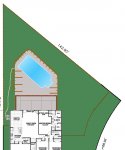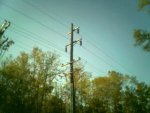Hey guys, I am happy to say that we finally got our pool installed, and yes I will definitely post some pics as soon as I can.
BUT, we are currently (no pun intended) dealing with a "shocking" sensation when touching the concrete deck and water at the same time. OR when sitting with feet in pool and touching the handrail by the steps. We only notice it in "open" wounds or scratches on our fingers. It's not very strong, but it's there.
I have read a number of threads here and it seems that a few others have been through similar issues. I would like to hear from some of them to hear their resolutions or fixes. I read one post by "cubbie" about putting a ground rod by the equip pad?? And I think MikeInTN said he has a ground rod also. Was your problems similar to mine, and if so did the rods eliminate the problems??? Will it help my situation?
It seems that John T is the man when it comes to this topic, so John T, here is what we know and have tried.....please help if you can my friend...
The pool is a polymer wall pool, so the PB says they don't bond it like metal wall pools. There is a metal coping aroun the pool so they run a bare copper wire from the metal coping, to the equip pad. They run the bare copper wire through an "eyelet", "coupling" thing on the booster pump and tighten it down, then run it over to the Hayward pump to a coupling thing and tighten it down. They say that's all they need to bond their pools.....Is this enough???
The concrete deck does not have rebar in it (not my choice). They use small strips between joints called "key-way" (not sure on spelling). It looks like either galvinized strips or aluminum strips, not sure on that.... No wires going from ladder rails to coping, or from handrail to coping...I thought they should have connected them, but they say they "do all their pools this way" and never have any problems.... Of course I'M THE FIRST, right? Just my luck!!!
When I called them, the pb said it was the electrician's problem. He said that the electrician did not separate the ground from the neutral in the sub-panel he put up for the pool. I called the electrician and he came and did this by adding a bar inside the sub-panel to separate the ground and neutrals. Still feel the shock.
The pb came out and disconnected the bond wire from the pumps, still there. He disconnected the grounds in the box, still there. He disconnected the hots, still there. He pulled the breakers out of the sub-panel box,,,,still there. I went to the main breaker on the house, turned off the main power breaker,,,, and IT'S STILL THERE.... We put a multimeter on the cement to the water and got a reading of .25 to .27 volts, even when the main was off.
SOOO, I called the power company, and they are sending out someone today to take a look.... Do you guys have any suggestions on this??? The shock therapy would probably do me some good every now and then, but our visitors might take offense.....hehe
Thanks in advance guys for all the help, and sorry to start a new thread on an old subject, but you know.....
Thanks,,,,DMAN
BUT, we are currently (no pun intended) dealing with a "shocking" sensation when touching the concrete deck and water at the same time. OR when sitting with feet in pool and touching the handrail by the steps. We only notice it in "open" wounds or scratches on our fingers. It's not very strong, but it's there.
I have read a number of threads here and it seems that a few others have been through similar issues. I would like to hear from some of them to hear their resolutions or fixes. I read one post by "cubbie" about putting a ground rod by the equip pad?? And I think MikeInTN said he has a ground rod also. Was your problems similar to mine, and if so did the rods eliminate the problems??? Will it help my situation?
It seems that John T is the man when it comes to this topic, so John T, here is what we know and have tried.....please help if you can my friend...
The pool is a polymer wall pool, so the PB says they don't bond it like metal wall pools. There is a metal coping aroun the pool so they run a bare copper wire from the metal coping, to the equip pad. They run the bare copper wire through an "eyelet", "coupling" thing on the booster pump and tighten it down, then run it over to the Hayward pump to a coupling thing and tighten it down. They say that's all they need to bond their pools.....Is this enough???
The concrete deck does not have rebar in it (not my choice). They use small strips between joints called "key-way" (not sure on spelling). It looks like either galvinized strips or aluminum strips, not sure on that.... No wires going from ladder rails to coping, or from handrail to coping...I thought they should have connected them, but they say they "do all their pools this way" and never have any problems.... Of course I'M THE FIRST, right? Just my luck!!!
When I called them, the pb said it was the electrician's problem. He said that the electrician did not separate the ground from the neutral in the sub-panel he put up for the pool. I called the electrician and he came and did this by adding a bar inside the sub-panel to separate the ground and neutrals. Still feel the shock.
The pb came out and disconnected the bond wire from the pumps, still there. He disconnected the grounds in the box, still there. He disconnected the hots, still there. He pulled the breakers out of the sub-panel box,,,,still there. I went to the main breaker on the house, turned off the main power breaker,,,, and IT'S STILL THERE.... We put a multimeter on the cement to the water and got a reading of .25 to .27 volts, even when the main was off.
SOOO, I called the power company, and they are sending out someone today to take a look.... Do you guys have any suggestions on this??? The shock therapy would probably do me some good every now and then, but our visitors might take offense.....hehe
Thanks in advance guys for all the help, and sorry to start a new thread on an old subject, but you know.....
Thanks,,,,DMAN




